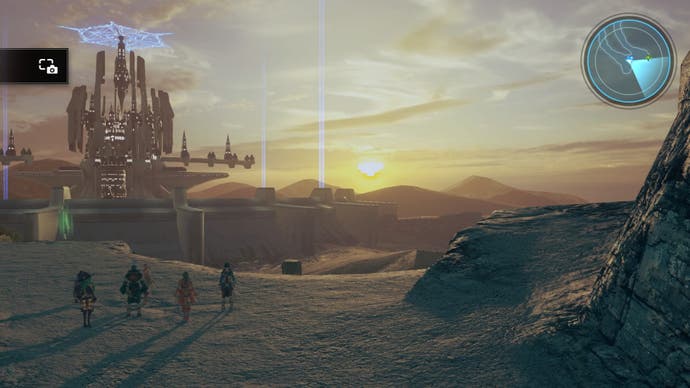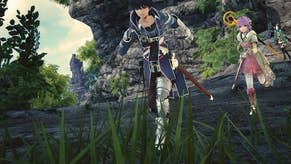Star Ocean: Integrity and Faithlessness review
A drop in the ocean.
When Star Ocean debuted on the Super Famicom 20 years ago the RPG, an American import that Japan made its own with pinch of Shintoism and a dollop of anime, was poised to change video games. The previous year Chrono Trigger had brought together Final Fantasy's Hironobu Sakaguchi and Dragon Quest's Yuji Horii, a muscular collaboration that squared each respective team's talents to deliver a masterpiece.
The following year Final Fantasy 7 broke the genre from its niche and, with the processing power of PlayStation, or, more precisely, the storage power of CD-Rom discs, steered the video game blockbuster forever away from Nintendo's pristine platformers toward high-production cinema. New and lavish JRPGs arrived every month. Then production costs rose and sales fell. The games became fewer, and thinner. Now, in a shift that would have been unimaginable back in 1996, the Polish have usurped the Japanese as masters of the American role-playing game.
It may seem unfair to compare Star Ocean, the prog opera of the JRPG line-up, to The Witcher 3, CD Projekt's HBO epic. For one, tri-Ace's game mixes the mediaeval fantasy with spaceships and sci-fi (an unusual but not entirely unworkable brew). Nevertheless, similarities abound. Both aspire to present a lavish and geographically diverse world, from snow-burdened mountains to Sound of Music-esque green plains, each scene filled with a hotchpotch of monsters and bisected by a grandiose storyline. Both games dispense of the genre's turn-based foundations, instead featuring real time combat that mixes sword-fighting, magic and item tossing. Both games heavily feature item crafting and alchemy. And both games offer a core storyline that is supplemented with freelance missions posted to notice boards in local towns.

On every count, The Witcher shows up its Eastern rival both for a poverty of imagination (the numbing clichés of storytelling which centre on the mystery of an amnesiac child who wields extraordinary powers) and, seemingly, its strained development budget. This latter shortcoming is best exemplified by those notice board quests. In The Witcher, each time Geralt of Rivia takes on one of these missions you expect adventure. You expect to be introduced to memorable characters and monsters, and to have to wrestle with a morally ambiguous choice. In Star Ocean, by contrast, when Fidel Camuze takes on one of these missions you simply click on the same notice board a second time, select the required bunch of herbs or monster droppings from the menu, and, lo, you're done.
Star Ocean, is not quite an open world RPG - it's still, in blueprint, a series of towns linked by winding, outdoorsy corridors - but it's clear that its development team had sweeping aspirations. As well as crafting and alchemy, once you unlock the relevant skills you are able to go fishing and mining for resources in the field. In the malnourished Star Ocean universe, however, the only distinction between these two activities is the colour of the shimmering light on which you must click in order to harvest your reward (some loose change, experience points and, if you're lucky, an item or two). It's placeholder game design.
Protagonist Camuze is the son of a military general, stationed - implausibly for someone of his age, to protect a coastal town from invaders. Following a minor attack, Camuze decides that his home is under-protected, and sets off to find his father in order to request more troops. It's a somewhat pedestrian but motivating enough start, that soon evolves into a grander tale once you happen upon the amnesiac moon-child.
The performances, however, have the ambiance of a local repertoire theatre production, a feel compounded by the game's clunky, conspicuous translation and some niggling load times before each line of asinine dialogue is muttered.
"My friends... my toys... my sister..." asks the amnesiac girl as she looks around a nursery that jogs her memory later in the game.
"Did something just come back to you, Relia?" replies Camuze, idiotically.
The script is further wrecked by the Disneyland-mascot style delivery of its voice actors. Square Enix is clearly not aiming for an austere, prestige TV-esque feel here -- this is a game aimed at a younger anime fans -- but even within the forgiving parameters of the niche, it feels amateurish and, set against the better examples in the publisher's own oeuvre, outdated.
This carelessness of craft can be perceived even in the surface element of character design. One team member, Fiore, a supposedly high ranking magician-cum-politician totters about on a pair of stratospheric heels while wearing a chequerboard dress that alternates between squares of black fabric and squares of pink skin. To round off the ensemble: a cat's tail flourish, drawn from her rear. Ignoring the fact that this is perilously impractical armour, the outfit does not match Fiore's status. As such, you cannot shake the feeling that these are characters designed to appeal to the cos-player more than any kind of narrative interrelation. Enemy designs are similarly scattershot. One moment you'll be fighting hook-nosed child goblins. The next: weaponised polyhedral dice.

The series' strongest suit is its battle system, which has always allowed you to blaze through groups of monsters with whip-quick pleasure. In Integrity and Faithlessness, the system - which is simpler and less interesting than 2009's The Last Hope - is built on a rock, paper, scissors triangle in which weak attacks interrupt strong attacks; strong attacks break guards; guards stops weak attacks. You tap a button for a short attack and hold it down to trigger a longer, MP-draining alternative. Later, screen-filling multi-character attacks similar to Final Fantasy's summons can be used when you amass the necessary meter, although choosing to hold onto this resource will increase the amount of experience points and money you earn. You control one character in your team - the others (up to six at a time) are handled by the AI, which acts according to unlockable and upgradeable behaviours you equip to each characters - up to four per fighter.
Despite its title, this is principally a land-locked game. After a dozen hours or so you gain access to a spaceship, the weirdly named Charles D. Goale, but the blinking ship is used primarily as a home-base, to which you return to stock up on supplies, or trigger cutscenes. On the ground, this is a game defined by extreme backtracking. Star Ocean's society may have warp drives that can carry them to space, but they're yet to invent the telephone. Trudging is the game's padding. The tragedy here is that, at times, this is a beautiful game: the terrain is endlessly picturesque, but it's just so barren. Occasionally you might stumble across a purplish portal out in the wild that, if entered, will deliver you to a bonus dungeon, but this is one of the only meagre diversions on offer. Star Ocean is otherwise vacant.
It's also a relatively short game - around a third the size of the previous game. This is no criticism: what JRPG would not have been improved by a ruthless edit? Its relative brevity, however, likely speaks to developmental issues, presumably the disparity between the cost of making one of these cathedral-like games, and its publisher's expected return on the investment. Star Ocean feels simultaneously unfinished and under-scoped. It is a minor story situated in a minor world, one that will leave, even to its series' staunchest fans, a minor impression.











